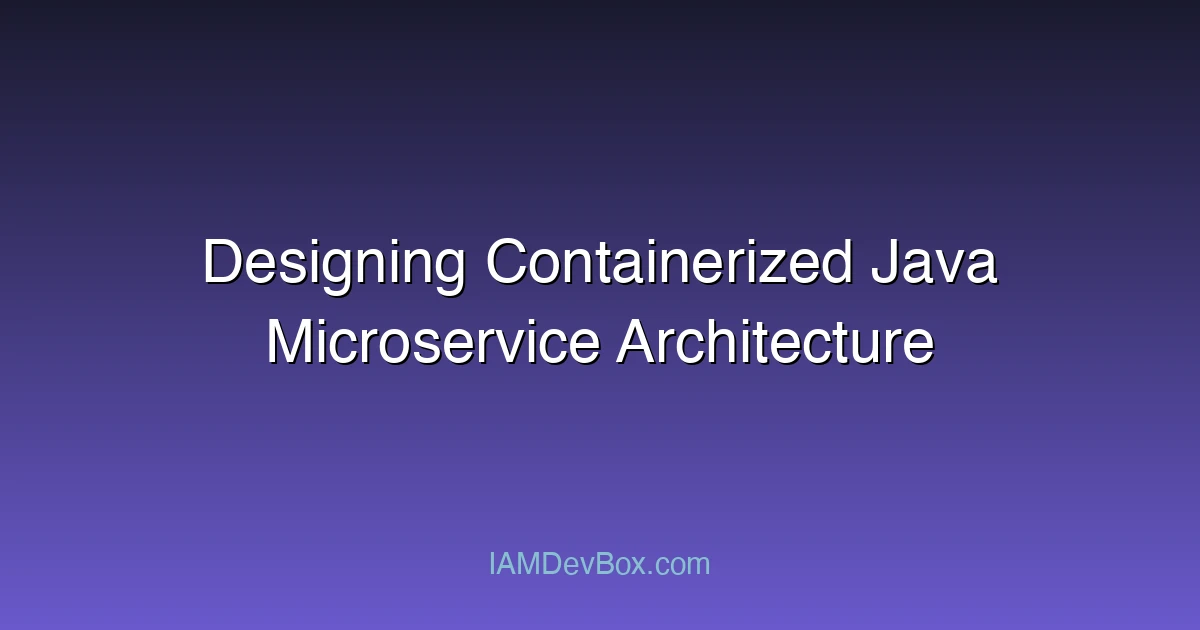Visual Overview:
graph TB
subgraph "Microservices Authentication"
Client[Client] --> Gateway[API Gateway]
Gateway --> Auth[Auth Service]
Auth --> TokenStore[(Token Store)]
Gateway --> ServiceA[Service A]
Gateway --> ServiceB[Service B]
Gateway --> ServiceC[Service C]
ServiceA --> ServiceB
ServiceB --> ServiceC
end
style Gateway fill:#667eea,color:#fff
style Auth fill:#764ba2,color:#fff
In the rapidly evolving landscape of software development, the shift towards microservices has revolutionized how applications are built and deployed. This blog post delves into the design of containerized Java microservice architecture, exploring its benefits, tools, and considerations.
What is a Microservice Architecture?
A microservice architecture structures an application as a collection of loosely coupled, independently deployable services. Unlike monolithic applications, where all components are tightly integrated, microservices offer modularity, allowing each service to be developed, deployed, and scaled independently.
Benefits of Microservices:
- Modularity: Easier to develop and maintain individual services.
- Scalability: Services can be scaled based on demand.
- Technology Diversity: Different services can use different technologies.
Containerization with Docker
Docker is a containerization platform that packages code and dependencies into containers, ensuring consistent runtime environments across different platforms. Containers are lightweight and efficient, making them ideal for microservices.
Key Docker Concepts:
- Docker Images: Read-only templates that define the container’s environment.
- Docker Containers: Running instances of images.
Why Docker for Microservices?
- Facilitates deployment and scaling.
- Ensures consistency across development, testing, and production environments.
Designing the Architecture
Designing a microservice architecture involves several considerations:
- Service Discovery: Mechanisms for services to find and communicate with each other.
- API Gateway: Acts as a front door, routing requests to appropriate services.
- Circuit Breakers: Prevents cascading failures by detecting and handling service unavailability.
- Load Balancing: Distributes traffic efficiently across services.
Implementing with Java
Java, with its robust ecosystem, is well-suited for microservices. Frameworks like Spring Boot simplify building microservices.
Example: A Simple Microservice with Spring Boot
@SpringBootApplication
public class ProductServiceApplication {
public static void main(String[] args) {
SpringApplication.run(ProductServiceApplication.class, args);
}
}
@RestController
@RequestMapping("/api/products")
class ProductController {
@GetMapping("/{id}")
public Product getProduct(@PathVariable Long id) {
return productService.getProduct(id);
}
}
Containerizing with Docker
A Dockerfile for the above service:
FROM openjdk:11-jdk
WORKDIR /app
COPY target/*.jar app.jar
EXPOSE 8080
CMD ["java", "-jar", "app.jar"]
Build and run:
docker build -t product-service .
docker run -p 8080:8080 product-service
Challenges and Best Practices
Challenges:
- Communication between services.
- Data management across services.
- Monitoring and logging.
Best Practices:
- Use REST or gRPC for communication.
- Implement circuit breakers.
- Use tools like Prometheus for monitoring.
Case Study: E-commerce Platform
An e-commerce platform can be decomposed into microservices like Product Service, Order Service, and Payment Service. Each service handles specific functionalities, enhancing scalability and maintainability.
Conclusion
Containerized Java microservice architecture offers numerous benefits, including scalability and flexibility. By leveraging Docker and frameworks like Spring Boot, developers can efficiently build and deploy microservices.
Extended Questions:
- How would you handle cross-cutting concerns like logging and monitoring?
- What factors influence the choice between REST and gRPC?
By considering these aspects and best practices, developers can effectively design and implement containerized Java microservice architectures.
